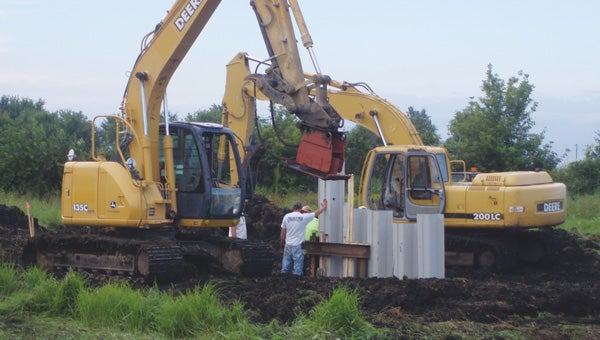Project to slow flood flows
Published 11:32 am Thursday, September 1, 2011

Workers break ground at a wetland restoration southeast of Dexter. The wetland will reduce water flow before it hits Dobbins Creek, a major contributor to flooding in Austin. Left: A tall berm with a special drainage system reduces storm-water flow into Dobbins Creek. -- Photos provided
A bunch of exposed topsoil, plastic fence and large berm just southwest of Dexter wouldn’t catch the attention of most who passed it along the road. But those simple things play one of the most important roles in protecting the watershed from flooding, according to conservationists.
Last week, Justin Hanson, watershed technician for the Ceder River Watershed District, and other workers completed a wetland restoration in one of the most critical areas they could have: the headwaters of Dobbins Creek. The area contains some of the fastest flows during heavy rains, and that water rushes into Austin. By creating the wetland, Hanson and his crew have made a damper where water will slow down even before it hits the river.
“Dobbins creek is a big contributor to the flooding issue in Austin, and a lot of that has to do with the velocity,” Hanson said.
With $34,000 in state funds from the Conservation Reserve Enhancement Program, the crew broke tile lines that were in the ground, created a large berm to halt water at the bottom of a hill, and put a channel into the berm that will reduce heavy storm-water flows.
The CRWD wanted to create the wetland adjacent to Dobbins for several years. And according to Justin Hanson, everything came together perfectly. The crew couldn’t have asked for a better location for its conservation project.
“If we could have handpicked a site, this would have been the one to do,” Hanson said.
However, CRWD had luck on its side, too. The property owner, an elderly woman, wanted her land to remain there for future generations, and she was very accommodating for conservationists like Hanson.
“She’s one of the sweetest ladies we’ve ever worked with,” he said.
“She just wanted to make sure that it kind of stayed in the family and that the land was kind of protected.”
Several weeks ago, Hanson and others repaired a stream bank along Dobbins near Brownsdale, which will reduce sediment in the water. However, this wetland restoration near Dexter has several benefits. Among flood reduction, prairie grasses, native grasses and marshy conditions will provide a haven for wildlife.
“I’m really looking forward to it,” Hanson said. “That natural vegetation is going to come back really nice, and the prairie grasses took off really well, too.”
The wetland also creates a natural buffer, so less sediment from field runoff can enter Dobbins. Because this type of project has so many benefits, Hanson already has plans to work on two more wetland restorations in October.


